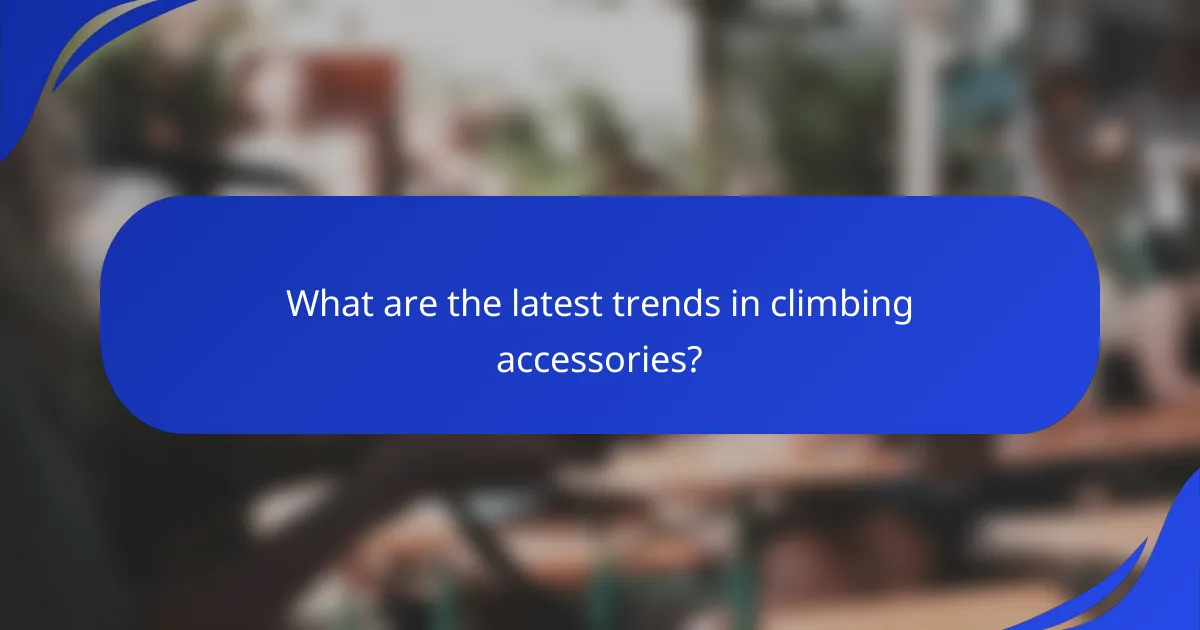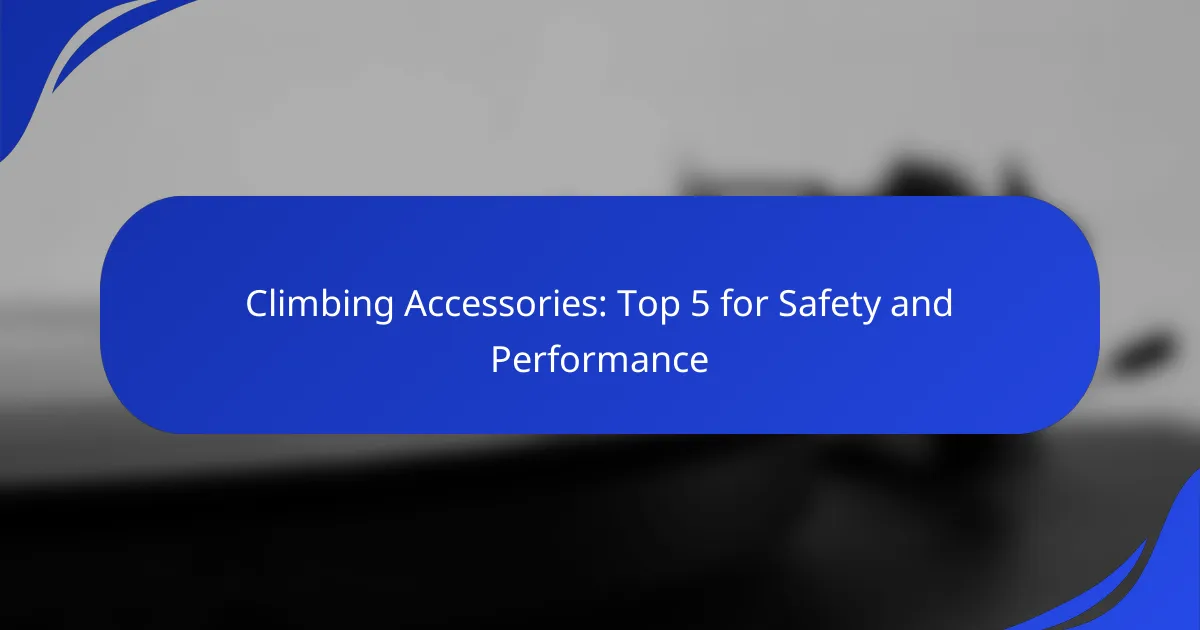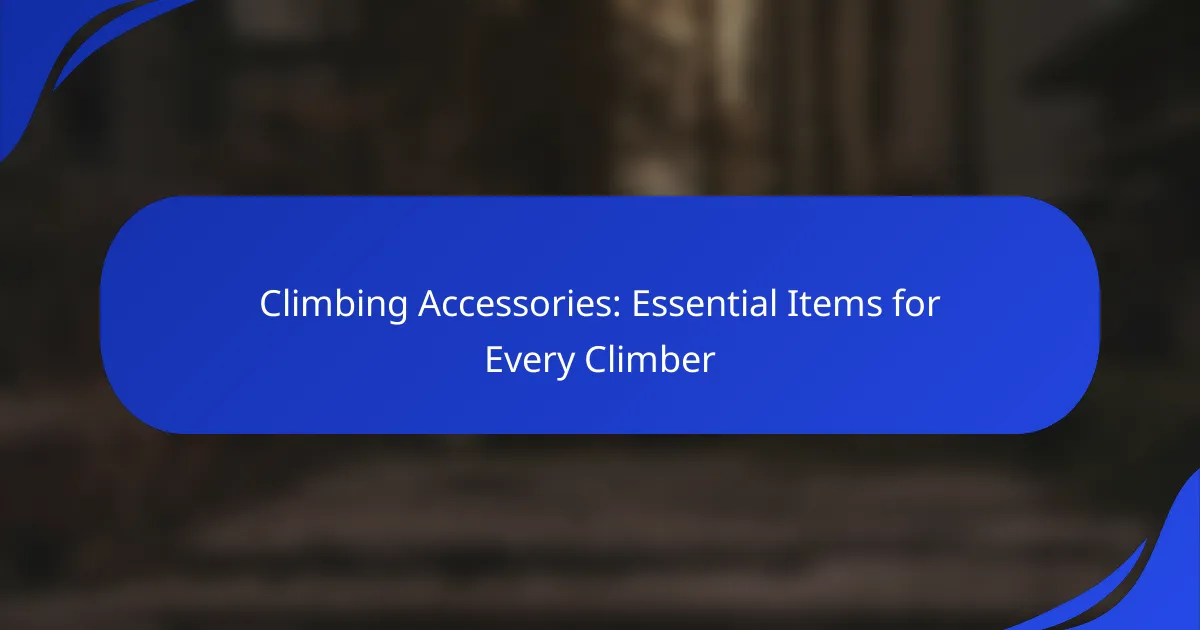Climbing accessories play a vital role in enhancing both safety and performance on the rock face. By providing essential protection and improving efficiency, these tools allow climbers to focus on their technique and achieve their goals with confidence. Selecting the right gear is crucial, as it ensures compatibility with your climbing style while minimizing risks associated with the sport.

What are the top climbing accessories for safety?
The top climbing accessories for safety include essential gear that enhances protection and performance while climbing. These accessories are crucial for minimizing risks and ensuring a secure climbing experience.
Climbing harnesses
Climbing harnesses are vital for securing a climber to the rope and distributing the load during a fall. When choosing a harness, consider factors such as fit, comfort, and type—whether it’s a sit harness, full-body harness, or sport-specific model.
Look for harnesses that meet safety standards like UIAA or CE. A well-fitted harness should allow for movement while ensuring it remains snug, particularly around the waist and legs.
Climbing helmets
Climbing helmets protect the head from falling debris and impacts. They come in two main types: hard-shell and foam, with hard-shell helmets offering greater protection for rock climbing and foam helmets being lighter for sport climbing.
Ensure the helmet fits properly and is comfortable for extended wear. Check for certifications such as UIAA or CE to guarantee safety standards are met.
Belay devices
Belay devices are crucial for controlling the rope during climbing and rappelling. They can be tube-style, assisted-braking, or figure-eight, each offering different levels of control and ease of use.
When selecting a belay device, consider compatibility with the rope diameter and your climbing style. Practice using the device to ensure proficiency and safety during climbs.
Carabiners
Carabiners are essential for connecting various components of climbing gear, such as harnesses, ropes, and anchors. They come in different shapes and locking mechanisms, including screw-lock and auto-lock styles.
Choose carabiners based on their intended use—lightweight options for sport climbing and heavier-duty ones for trad climbing. Always check for the strength rating, typically measured in kilonewtons (kN), to ensure they meet safety requirements.
Ropes
Climbing ropes are critical for safety, with dynamic ropes designed to stretch and absorb falls, while static ropes are used for rappelling and hauling. The choice of rope depends on the type of climbing being done.
Look for ropes that meet UIAA standards and consider factors like diameter and length. A typical dynamic rope ranges from 9.5mm to 11mm in diameter, providing a balance between weight and durability.

How do climbing accessories enhance performance?
Climbing accessories significantly enhance performance by improving safety, efficiency, and comfort during climbs. They are designed to optimize grip, energy transfer, and overall climbing experience, allowing climbers to focus on their technique and reach their goals.
Improved grip with climbing shoes
Climbing shoes are essential for providing the grip needed to ascend various surfaces. They feature a rubber sole that maximizes friction, allowing climbers to securely place their feet on small footholds. When choosing climbing shoes, consider the fit, as a snug fit enhances sensitivity and control.
Look for shoes with a downturned shape for sport climbing or a more relaxed fit for trad climbing. The type of rubber used can also affect performance; softer rubber offers better grip but may wear out faster, while stiffer rubber provides durability and support.
Efficient energy transfer with harnesses
A harness plays a crucial role in energy transfer by distributing weight evenly across the body, which minimizes fatigue during climbs. A well-fitted harness allows for optimal movement and comfort, enabling climbers to maintain focus on their ascent rather than discomfort. Ensure the harness is adjusted correctly to prevent any slippage.
When selecting a harness, consider the type of climbing you will be doing. For sport climbing, a lightweight harness with minimal bulk is ideal, while a more padded harness may be preferable for long multi-pitch climbs. Always check for compliance with safety standards, such as those set by the UIAA or CE, to ensure reliability.

What should you consider when selecting climbing accessories?
When selecting climbing accessories, prioritize safety, compatibility with your climbing style, and the overall quality of materials. Understanding these factors ensures you choose gear that enhances performance while minimizing risks.
Compatibility with climbing style
Your climbing style significantly influences the type of accessories you need. For instance, sport climbers may prioritize quickdraws and harnesses designed for efficiency, while trad climbers require gear that supports placing protection. Assess your climbing habits to ensure your accessories align with your preferred techniques.
Consider the specific demands of your climbing environment as well. If you frequently climb in alpine conditions, look for accessories that offer weather resistance and adaptability to varied terrains.
Weight and portability
Weight and portability are crucial when selecting climbing accessories, especially for long ascents or multi-pitch climbs. Lightweight gear can reduce fatigue and enhance mobility, making it easier to navigate challenging routes. Aim for accessories that balance durability with a low weight profile.
For example, consider using ultralight carabiners and harnesses that pack down small. This allows for easy transport and less bulk in your climbing pack, which is essential for long approaches.
Durability and material quality
Durability and material quality are vital for ensuring the longevity and safety of your climbing accessories. Look for products made from high-quality materials that meet industry standards, such as those certified by the UIAA or CE. These certifications indicate that the gear has undergone rigorous testing for strength and reliability.
Regularly inspect your gear for signs of wear and tear, such as frayed straps or corrosion on carabiners. Replacing worn accessories promptly can prevent accidents and ensure your climbing experience remains safe and enjoyable.

Where to buy climbing accessories in the US?
In the US, climbing accessories can be purchased from various retailers, both in physical stores and online. Popular options include specialty outdoor retailers, e-commerce platforms, and general merchandise websites, each offering a range of products suited for safety and performance.
REI stores
REI is a leading outdoor retailer in the US, known for its extensive selection of climbing gear and accessories. You can find everything from harnesses and carabiners to climbing shoes and helmets at their locations across the country.
Shopping at REI allows you to receive expert advice from knowledgeable staff, and many stores offer climbing classes and events. Members can also benefit from discounts and a generous return policy, making it a great choice for both beginners and experienced climbers.
Backcountry online
Backcountry is a popular online retailer specializing in outdoor gear, including climbing accessories. Their website features a wide variety of brands and products, often with detailed descriptions and customer reviews to help you make informed choices.
Backcountry frequently offers sales and promotions, which can provide significant savings on high-quality climbing gear. They also have a user-friendly return policy, allowing you to shop with confidence.
Amazon climbing section
Amazon’s climbing section offers a vast array of climbing accessories, ranging from budget-friendly options to premium gear. The platform’s extensive inventory means you can find nearly any item you need, often with fast shipping options available.
While shopping on Amazon, pay attention to customer ratings and reviews to ensure product quality. It’s also wise to compare prices across different listings, as they can vary significantly for the same item.

What are the latest trends in climbing accessories?
The latest trends in climbing accessories focus on enhancing safety and performance while prioritizing sustainability. Innovations include advanced materials, smart technology integration, and eco-friendly designs that cater to both recreational and professional climbers.
Eco-friendly materials
Eco-friendly materials are becoming increasingly popular in climbing accessories, driven by a growing awareness of environmental impact. Manufacturers are now using recycled plastics, organic cotton, and biodegradable materials to create gear that minimizes ecological footprints.
When selecting eco-friendly climbing accessories, look for certifications such as Global Organic Textile Standard (GOTS) or OEKO-TEX, which ensure that products meet specific environmental and safety standards. Brands are also adopting practices like reducing water usage and chemical treatments in production.
Examples of eco-friendly climbing gear include harnesses made from recycled polyester and chalk bags crafted from organic cotton. These options not only reduce waste but also perform well under climbing conditions, providing safety and durability without compromising on environmental values.










